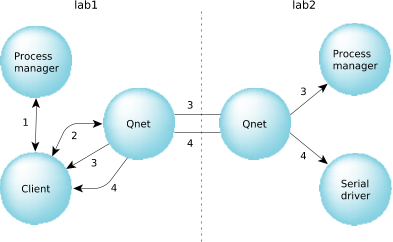Let's return to our open() example. Suppose a client on one node (lab1) wishes to use the serial port (/dev/ser1) on another node (lab2). The client will effectively perform an open() on the pathname /net/lab2/dev/ser1.
The following diagram shows the steps involved when the client open()'s /net/lab2/dev/ser1:
 Figure 1. A client-server message pass across the network.
Figure 1. A client-server message pass across the network.Here are the interactions:
- A message is sent from the client to its local process
manager, effectively asking who should be contacted to
resolve the pathname /net/lab2/dev/ser1.
Since the native network manager (lsm-qnet.so) has taken over the entire /net namespace, the process manager returns a redirect message, saying that the client should contact the local network manager for more information.
- The client then sends a message to the local network
manager, again asking who should be contacted to resolve the pathname.
The local network manager then replies with another redirect message, giving the node descriptor, process ID, and channel ID of the process manager on node lab2—effectively deferring the resolution of the request to node lab2.
- The client then creates a connection to the process
manager on node lab2, once again asking
who should be contacted to resolve the pathname.
The process manager on node lab2 returns another redirect, this time with the node descriptor, channel ID, and process ID of the serial driver on its own node.
- The client creates a connection to the serial driver on
node lab2, and finally gets a connection
ID that it can then use for subsequent message-passing operations.
After this point, from the client's perspective, message passing to the connection ID is identical to the local case. Note that all further message operations are now direct between the client and server.
The key thing to keep in mind here is that the client isn't aware of the operations taking place; these are all handled by the POSIX open() call. As far as the client is concerned, it performs an open() and gets back a file descriptor (or an error indication).